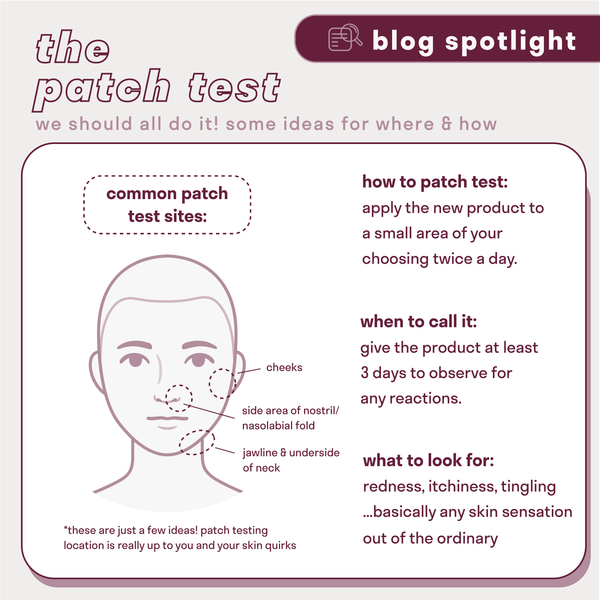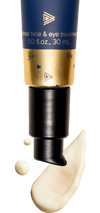One of the main “Chemists’ Skincare Commandments” we tout is that with any new product, we all should patch test, patch test, patch test! We know all too well that the skincare industry is never short of new, exciting, glitzy products to add to our skincare routine. As we integrate new products into our daily routines, the importance of understanding how skin reacts cannot be overstated. There are so many of us (yes, that’s us included) can get carried away, and if you’re not careful, you might find yourself with a one-way ticket to skin irritation town. Nursing back a bad skin reaction is not what any of us want to spend our skincare routine on!
Enter patch testing! - a simple yet crucial step that often gets overlooked. This isn’t just a method that’s solely reserved for sensitive skin types. People of all skin types can benefit from making patch testing a habit whenever you introduce a new product to your routine. So let’s dive right into this guide and discuss why you should patch test, how to patch test, and …..
Why Patch Test Skincare
The annoying reality is that it’s hard to know exactly what your skin triggers are. The culprit might actually be the most vanilla ingredient on the IL, the formula type, or even the unique combination of active ingredients. For example, you may be used to an 8% glycolic acid toner, but find your skin in hot waters after switching to another toner seemingly at the same active concentration level. This sudden bout of irritation may be caused by the different preservatives, fragrance, pH adjustor, supporting ingredient, etc. This is why it’s important to test any new skincare product, especially if you have sensitive and reactive skin.
How to patch test your skincare at home
Convinced that you should patch test more regularly? Let’s walk through just how to patch test properly.
Where do I apply the product when patch testing?
The first thing to do is figure out the best patch test area. Ideally, it should be an area where it won't be constantly rubbed and generally would be more prone to skin reactions. This can be slightly different between different individuals. Some common areas for patch testing: back of the hand, jawline/under the chin, underneath/around the nose area.
Okay! I’m ready, is there a special way to apply the product?
Apply the product as you normally would. Just rub fully into skin twice a day and observe any changes.
How long do I patch test for?
Apply the product twice a day daily for at least 3 days and monitor for skin reactions.
What products should I patch test?
You can test any standard leave-on product such as toners, serums, treatments, moisturizers, and sunscreen.
How do I test cleansers?
Rinse-off products like cleansers and rinse-off masks are different. These types of products are likely inherently irritating if you leave them on for much longer than instructed. That said, there are still things you can try to ease your skin into with these new products. For a cleanser, just use as instructed for ~a week and see if you notice symptoms like sudden skin dryness. For rinse-off masks, the easiest way to test is to use it for half of the instructed time length to assess. For example, if a mask instructs to rinse off after 10 minutes, just use it for 5 minutes the first few times to see if there’s any reaction.
What about retinol?
Retinol might be one of those funky product categories where patch test rules don’t really apply. These products can cause a reaction in many skin types - but over time skin will adapt as it goes through retinization. And this is a process that may take a few weeks or even months for skin to fully adjust. Generally speaking, light skin peeling, sensitivity, redness are all normal. But if skin enters the realm of pain and full fledged snake skin molting, the product may not be right for you. We would recommend to refer to our retinol article on general acclimation and on-boarding practices and avoid jumping into anything that’s high dose right off the bat.
How many products can I test at a time?
One! As tempting as it is to wipe out your entire routine in favor for a fancy new routine, replacing or trialing too many products at a time is not a great idea. Your skin is more likely to react to something, and it becomes even harder to narrow down the problem child.
Troubleshooting Patch Test Reaction
Ideally, the product you’re itching to use (no pun intended) doesn’t cause any reactions during the patch test. But if you notice mild reactions during your patch test, such as itching or redness, it’s a solid sign that the product isn’t a good fit for you. If a reaction develops at any point during a patch test, you can clean off the test site with a gentle cleanser, gift the product to a friend, and call it a day. No need to carry on to force skin to adapt or for the name of science!
In cases of mild irritation, it’s likely that skin will heal on its own within a day especially if you remove the offending product quickly. To help it heal faster, you can use a soothing moisturizer or occlusive balm over the area to help it along.
When to head to a dermatologist?
If you feel like your skin simply reacts to everything, or that your skin is chronically red/itchy/irritated, it may be time to schedule a derm consultation. A dermatologist can assess whether you have a particular skin trigger to help you put together a list of specific ingredients to avoid, or even diagnose potential underlying issues such as eczema or rosacea. Really understanding the root cause of your skin sensitivity can help put together a more tailored skincare routine with less trial-and-error going forward.
Takeaways

Buying that new serum you’ve been researching and eyeing for months can be very exciting! However, this can also be a risky process especially if you have sensitive or more reactive skin. Getting in the habit of patch testing your new skincare can save you a lot of heart aches in the long run. Just a few days of trialing a new product can give you a clear indicator of whether it’s right for your skin or not. In the long run, we’ll all spend way more time focused on good skin days and much less on the not-so-fun troubleshooting stuff.






